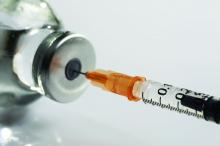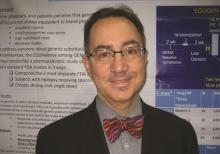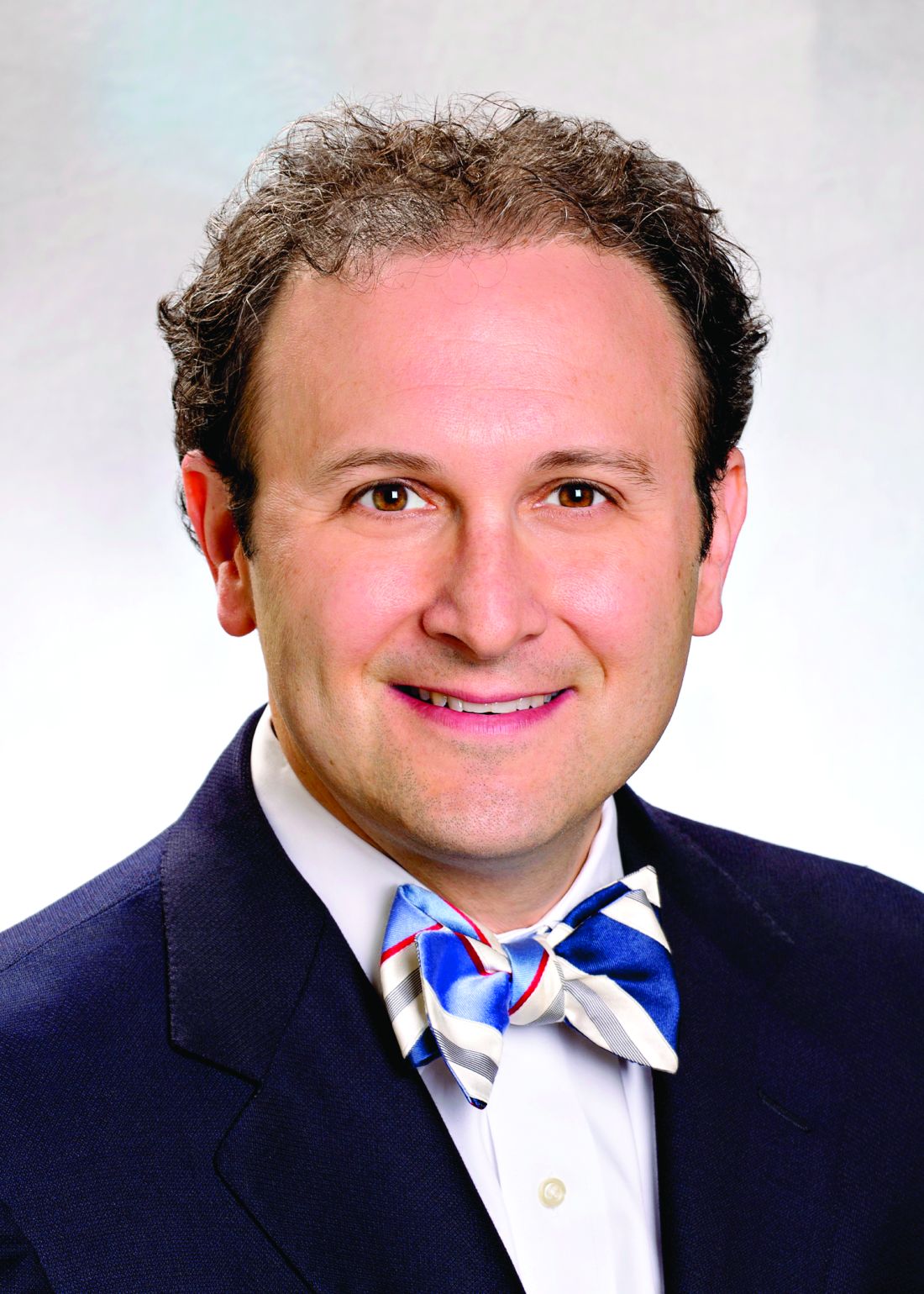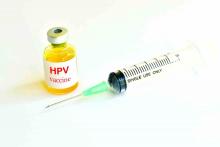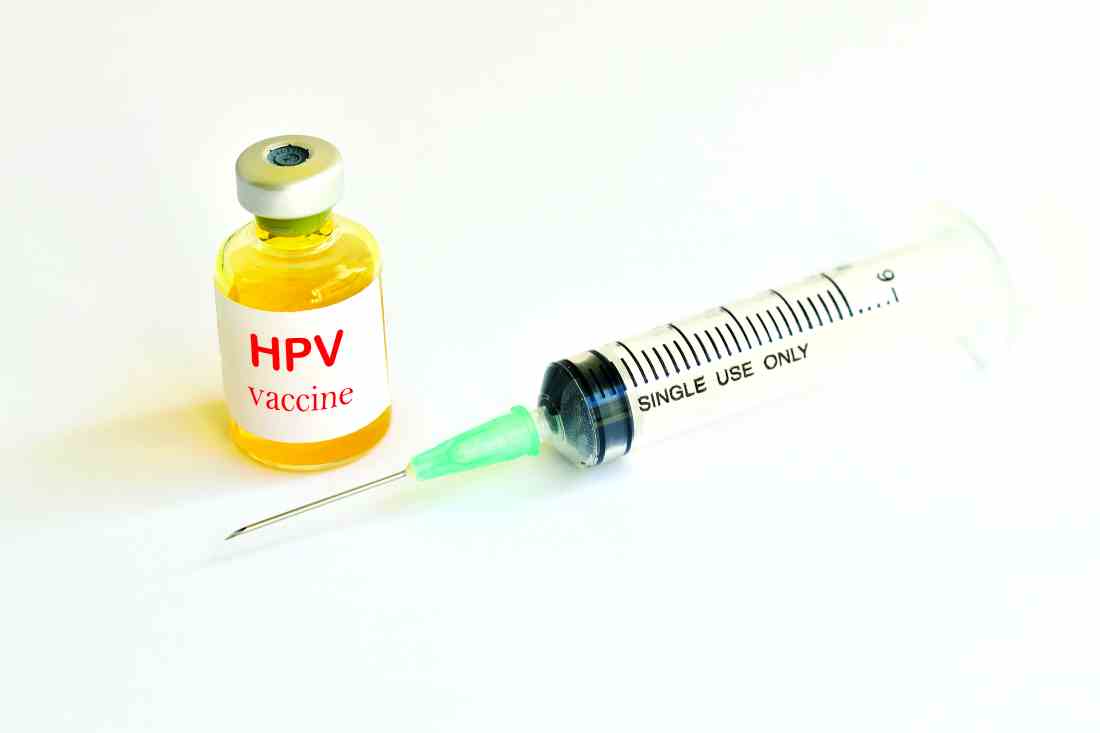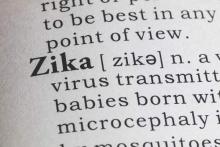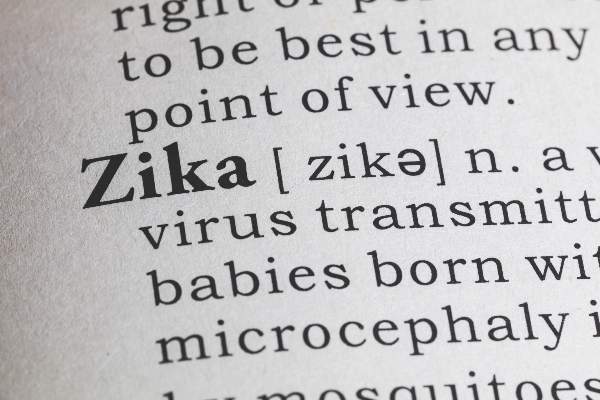User login
2014-2015 influenza vaccine ineffective against predominant strain
The 2014-2015 influenza vaccines offered little protection against the predominant influenza A/H3N2 virus, but were effective against influenza B, according to the vaccine effectiveness estimates provided by the U.S. Flu Vaccine Effectiveness Network.
Preferential use of the live attenuated influenza vaccine (LAIV) among young children, a recommendation previously published by the Advisory Committee on Immunization Practices, was not supported.
During the 2014-2015 influenza season, a total of 9,710 patients seeking outpatient medical treatment for acute respiratory infection with cough were enrolled into the U.S. Flu Vaccine Effectiveness study, reported Richard Zimmerman, MD, of the University of Pittsburgh, and his colleagues (Clin Infect Dis. 2016 Oct 4. doi: 10.1093/cid/ciw635).
Of these, 9,311 participants had complete data, and 7,078 (76%) tested negative for influenza. A total of 1,840 participants tested positive for influenza A – 99% of these cases were strain A/H3N2 – and 395 participants tested positive for influenza B.
Of the 4,360 vaccinated participants with known vaccine type, 39.7% received standard dose trivalent, 1.6% received high dose trivalent, 46.8% received standard dose quadrivalent, and 11.9% received quadrivalent live-attenuated vaccines.
For influenza A and B combined, the overall adjusted vaccine effectiveness was 19% (95% Confidence Interval, 10-27%) against all medically attended influenza and was statistically significant in all age groups except 18-49 years.
Across all vaccine types, the vaccine effectiveness for the A/H3N2 strain was 6% (95% CI, -5-17%), estimates were similar across all age groups, and all vaccine types were similarly ineffective. These estimates were “consistent with a mismatch between the vaccine and circulating viruses,” the researchers noted.
Overall vaccine effectiveness for influenza B/Yamagata was 55% (95% CI, 43% to 65%) and was similarly significant in all age strata except 50-64 year olds. Trivalent vaccines were more effective at preventing influenza B and, of note, no cases of influenza B occurred among those who received a high dose trivalent flu vaccine.
The study was supported by the Centers for Disease Control and Prevention and the National Institutes of Health. Dr. Zimmerman and four other investigators reported receiving research funding from several pharmaceutical companies.
[email protected]
On Twitter @jessnicolecraig
The 2014-2015 influenza vaccines offered little protection against the predominant influenza A/H3N2 virus, but were effective against influenza B, according to the vaccine effectiveness estimates provided by the U.S. Flu Vaccine Effectiveness Network.
Preferential use of the live attenuated influenza vaccine (LAIV) among young children, a recommendation previously published by the Advisory Committee on Immunization Practices, was not supported.
During the 2014-2015 influenza season, a total of 9,710 patients seeking outpatient medical treatment for acute respiratory infection with cough were enrolled into the U.S. Flu Vaccine Effectiveness study, reported Richard Zimmerman, MD, of the University of Pittsburgh, and his colleagues (Clin Infect Dis. 2016 Oct 4. doi: 10.1093/cid/ciw635).
Of these, 9,311 participants had complete data, and 7,078 (76%) tested negative for influenza. A total of 1,840 participants tested positive for influenza A – 99% of these cases were strain A/H3N2 – and 395 participants tested positive for influenza B.
Of the 4,360 vaccinated participants with known vaccine type, 39.7% received standard dose trivalent, 1.6% received high dose trivalent, 46.8% received standard dose quadrivalent, and 11.9% received quadrivalent live-attenuated vaccines.
For influenza A and B combined, the overall adjusted vaccine effectiveness was 19% (95% Confidence Interval, 10-27%) against all medically attended influenza and was statistically significant in all age groups except 18-49 years.
Across all vaccine types, the vaccine effectiveness for the A/H3N2 strain was 6% (95% CI, -5-17%), estimates were similar across all age groups, and all vaccine types were similarly ineffective. These estimates were “consistent with a mismatch between the vaccine and circulating viruses,” the researchers noted.
Overall vaccine effectiveness for influenza B/Yamagata was 55% (95% CI, 43% to 65%) and was similarly significant in all age strata except 50-64 year olds. Trivalent vaccines were more effective at preventing influenza B and, of note, no cases of influenza B occurred among those who received a high dose trivalent flu vaccine.
The study was supported by the Centers for Disease Control and Prevention and the National Institutes of Health. Dr. Zimmerman and four other investigators reported receiving research funding from several pharmaceutical companies.
[email protected]
On Twitter @jessnicolecraig
The 2014-2015 influenza vaccines offered little protection against the predominant influenza A/H3N2 virus, but were effective against influenza B, according to the vaccine effectiveness estimates provided by the U.S. Flu Vaccine Effectiveness Network.
Preferential use of the live attenuated influenza vaccine (LAIV) among young children, a recommendation previously published by the Advisory Committee on Immunization Practices, was not supported.
During the 2014-2015 influenza season, a total of 9,710 patients seeking outpatient medical treatment for acute respiratory infection with cough were enrolled into the U.S. Flu Vaccine Effectiveness study, reported Richard Zimmerman, MD, of the University of Pittsburgh, and his colleagues (Clin Infect Dis. 2016 Oct 4. doi: 10.1093/cid/ciw635).
Of these, 9,311 participants had complete data, and 7,078 (76%) tested negative for influenza. A total of 1,840 participants tested positive for influenza A – 99% of these cases were strain A/H3N2 – and 395 participants tested positive for influenza B.
Of the 4,360 vaccinated participants with known vaccine type, 39.7% received standard dose trivalent, 1.6% received high dose trivalent, 46.8% received standard dose quadrivalent, and 11.9% received quadrivalent live-attenuated vaccines.
For influenza A and B combined, the overall adjusted vaccine effectiveness was 19% (95% Confidence Interval, 10-27%) against all medically attended influenza and was statistically significant in all age groups except 18-49 years.
Across all vaccine types, the vaccine effectiveness for the A/H3N2 strain was 6% (95% CI, -5-17%), estimates were similar across all age groups, and all vaccine types were similarly ineffective. These estimates were “consistent with a mismatch between the vaccine and circulating viruses,” the researchers noted.
Overall vaccine effectiveness for influenza B/Yamagata was 55% (95% CI, 43% to 65%) and was similarly significant in all age strata except 50-64 year olds. Trivalent vaccines were more effective at preventing influenza B and, of note, no cases of influenza B occurred among those who received a high dose trivalent flu vaccine.
The study was supported by the Centers for Disease Control and Prevention and the National Institutes of Health. Dr. Zimmerman and four other investigators reported receiving research funding from several pharmaceutical companies.
[email protected]
On Twitter @jessnicolecraig
Key clinical point:
Major finding: Across all vaccine types, the vaccine effectiveness for the A/H3N2 strain was 6%.
Data source: Retrospective analysis of 9,710 patients who sought outpatient medical treatment during the 2014-2015 influenza season.
Disclosures: The study was supported by the Centers for Disease Control and Prevention and the National Institutes of Health. Dr. Zimmerman and four other investigators reported receiving research funding from several pharmaceutical companies.
Dengue vaccine beneficial only in moderate to high transmission settings
Pediatric patients with previous natural exposure to dengue virus benefit from the dengue virus vaccine, while vaccination of seronegative patients leads to an increased risk for hospitalization because of dengue, according to the results of a mathematical model simulation.
Because of the first approved dengue vaccine’s highly variable efficacy rates among pediatric patients, the vaccine should only be used in moderate to high transmission settings, the investigators who designed the model concluded in a paper published in Science.
Dengvaxia, developed by Sanofi-Pasteur, is a recombinant chimeric live attenuated dengue virus vaccine based on a yellow fever vaccine backbone. The vaccine’s development was “considerably more challenging than for other Flavivirus infections because of the immunological interactions between the four dengue virus serotypes and the risk of immune-mediated enhancement of disease” which causes secondary infections to lead to more severe disease, Neil Ferguson, PhD, of the Imperial College of London and his associates wrote (Science. 2016 Sep 2;353:1033-6. doi: 10.1126/science.aaf9590).
Despite the complexity of the virus and vaccine, Dengvaxia was recently approved for use in six countries, and two large multicenter phase III clinical trials recently concluded. Investigators for the trials, which involved over 30,000 children in Southeast Asia and Latin America, reported an overall vaccine efficacy of about 60% in cases of symptomatic dengue disease. However, the vaccine’s efficacy varied by severity of dengue infection and by age and serotype of the patient at time of vaccination. Investigators for both trials reported higher efficacy in patients with severe infection and in patients who were seropositive for dengue virus (indicating previous exposure to the virus) at the time of vaccination. In addition, investigators for both trials reported lower vaccine efficacies in younger patients, a pattern “consistent with reduced efficacy in individuals who have not lived long enough to experience a natural infection,” the authors noted.
In an effort to provide guidance for future clinical trials and to predict the impact of wide-scale use of Dengvaxia, investigators developed a mathematical model of dengue transmission based on data from the two trials.
The model confirmed that secondary infections were nearly twice as likely to cause symptomatic infection, compared with primary and postsecondary infections.
In a highly important result, the model simulation showed that seropositive recipients always gained a substantial benefit – more than a 90% reduction in the risk of hospitalization because of dengue – from vaccination. However, among seronegative recipients, the vaccine initially induced near-perfect protection, but this protection rapidly decayed (mean duration, 7 months). Moreover, the model showed that seronegative recipients who received the vaccine were at an increased risk for hospitalization with dengue.
“This is true both in the short term and in the long term and raises fundamental issues about individual versus population benefits of vaccination,” investigators wrote. “Individual serological testing, if feasible, might radically improve the benefit-risk trade-off.”
The model also demonstrated that the optimal age for vaccination depends on the transmission intensity rate in a region where a child lives. In high-transmission settings, the optimal age to target for vaccination can be 9 years or younger, and as intensity of transmission decreases, optimal age of vaccination should increase, according to investigators.
The study was funded by the UK Medical Research Council, the UK National Institute of Health Research, the National Institutes of Health, and the Bill and Melinda Gates Foundation. Authors did not report any relevant disclosures.
[email protected]
On Twitter @jessnicolecraig
Pediatric patients with previous natural exposure to dengue virus benefit from the dengue virus vaccine, while vaccination of seronegative patients leads to an increased risk for hospitalization because of dengue, according to the results of a mathematical model simulation.
Because of the first approved dengue vaccine’s highly variable efficacy rates among pediatric patients, the vaccine should only be used in moderate to high transmission settings, the investigators who designed the model concluded in a paper published in Science.
Dengvaxia, developed by Sanofi-Pasteur, is a recombinant chimeric live attenuated dengue virus vaccine based on a yellow fever vaccine backbone. The vaccine’s development was “considerably more challenging than for other Flavivirus infections because of the immunological interactions between the four dengue virus serotypes and the risk of immune-mediated enhancement of disease” which causes secondary infections to lead to more severe disease, Neil Ferguson, PhD, of the Imperial College of London and his associates wrote (Science. 2016 Sep 2;353:1033-6. doi: 10.1126/science.aaf9590).
Despite the complexity of the virus and vaccine, Dengvaxia was recently approved for use in six countries, and two large multicenter phase III clinical trials recently concluded. Investigators for the trials, which involved over 30,000 children in Southeast Asia and Latin America, reported an overall vaccine efficacy of about 60% in cases of symptomatic dengue disease. However, the vaccine’s efficacy varied by severity of dengue infection and by age and serotype of the patient at time of vaccination. Investigators for both trials reported higher efficacy in patients with severe infection and in patients who were seropositive for dengue virus (indicating previous exposure to the virus) at the time of vaccination. In addition, investigators for both trials reported lower vaccine efficacies in younger patients, a pattern “consistent with reduced efficacy in individuals who have not lived long enough to experience a natural infection,” the authors noted.
In an effort to provide guidance for future clinical trials and to predict the impact of wide-scale use of Dengvaxia, investigators developed a mathematical model of dengue transmission based on data from the two trials.
The model confirmed that secondary infections were nearly twice as likely to cause symptomatic infection, compared with primary and postsecondary infections.
In a highly important result, the model simulation showed that seropositive recipients always gained a substantial benefit – more than a 90% reduction in the risk of hospitalization because of dengue – from vaccination. However, among seronegative recipients, the vaccine initially induced near-perfect protection, but this protection rapidly decayed (mean duration, 7 months). Moreover, the model showed that seronegative recipients who received the vaccine were at an increased risk for hospitalization with dengue.
“This is true both in the short term and in the long term and raises fundamental issues about individual versus population benefits of vaccination,” investigators wrote. “Individual serological testing, if feasible, might radically improve the benefit-risk trade-off.”
The model also demonstrated that the optimal age for vaccination depends on the transmission intensity rate in a region where a child lives. In high-transmission settings, the optimal age to target for vaccination can be 9 years or younger, and as intensity of transmission decreases, optimal age of vaccination should increase, according to investigators.
The study was funded by the UK Medical Research Council, the UK National Institute of Health Research, the National Institutes of Health, and the Bill and Melinda Gates Foundation. Authors did not report any relevant disclosures.
[email protected]
On Twitter @jessnicolecraig
Pediatric patients with previous natural exposure to dengue virus benefit from the dengue virus vaccine, while vaccination of seronegative patients leads to an increased risk for hospitalization because of dengue, according to the results of a mathematical model simulation.
Because of the first approved dengue vaccine’s highly variable efficacy rates among pediatric patients, the vaccine should only be used in moderate to high transmission settings, the investigators who designed the model concluded in a paper published in Science.
Dengvaxia, developed by Sanofi-Pasteur, is a recombinant chimeric live attenuated dengue virus vaccine based on a yellow fever vaccine backbone. The vaccine’s development was “considerably more challenging than for other Flavivirus infections because of the immunological interactions between the four dengue virus serotypes and the risk of immune-mediated enhancement of disease” which causes secondary infections to lead to more severe disease, Neil Ferguson, PhD, of the Imperial College of London and his associates wrote (Science. 2016 Sep 2;353:1033-6. doi: 10.1126/science.aaf9590).
Despite the complexity of the virus and vaccine, Dengvaxia was recently approved for use in six countries, and two large multicenter phase III clinical trials recently concluded. Investigators for the trials, which involved over 30,000 children in Southeast Asia and Latin America, reported an overall vaccine efficacy of about 60% in cases of symptomatic dengue disease. However, the vaccine’s efficacy varied by severity of dengue infection and by age and serotype of the patient at time of vaccination. Investigators for both trials reported higher efficacy in patients with severe infection and in patients who were seropositive for dengue virus (indicating previous exposure to the virus) at the time of vaccination. In addition, investigators for both trials reported lower vaccine efficacies in younger patients, a pattern “consistent with reduced efficacy in individuals who have not lived long enough to experience a natural infection,” the authors noted.
In an effort to provide guidance for future clinical trials and to predict the impact of wide-scale use of Dengvaxia, investigators developed a mathematical model of dengue transmission based on data from the two trials.
The model confirmed that secondary infections were nearly twice as likely to cause symptomatic infection, compared with primary and postsecondary infections.
In a highly important result, the model simulation showed that seropositive recipients always gained a substantial benefit – more than a 90% reduction in the risk of hospitalization because of dengue – from vaccination. However, among seronegative recipients, the vaccine initially induced near-perfect protection, but this protection rapidly decayed (mean duration, 7 months). Moreover, the model showed that seronegative recipients who received the vaccine were at an increased risk for hospitalization with dengue.
“This is true both in the short term and in the long term and raises fundamental issues about individual versus population benefits of vaccination,” investigators wrote. “Individual serological testing, if feasible, might radically improve the benefit-risk trade-off.”
The model also demonstrated that the optimal age for vaccination depends on the transmission intensity rate in a region where a child lives. In high-transmission settings, the optimal age to target for vaccination can be 9 years or younger, and as intensity of transmission decreases, optimal age of vaccination should increase, according to investigators.
The study was funded by the UK Medical Research Council, the UK National Institute of Health Research, the National Institutes of Health, and the Bill and Melinda Gates Foundation. Authors did not report any relevant disclosures.
[email protected]
On Twitter @jessnicolecraig
FROM SCIENCE
Key clinical point:
Major finding: Vaccine should only be used in moderate to high transmission settings. In high-transmission settings, the optimal age to target for vaccination is 9 years or younger.
Data source: Mathematical model simulation based on two large, multicenter, phase III clinical trials.
Disclosures: This study was funded by the UK Medical Research Council, the UK National Institute of Health Research, the National Institutes of Health, and the Bill and Melinda Gates Foundation. Authors did not report any relevant disclosures.
Unexplained subfertility in RA linked to periconceptional NSAID use
Women with rheumatoid arthritis are more often diagnosed with unexplained subfertility, compared with women in the general population, according to a new study published in Arthritis Care & Research.
This finding may imply that fertility in female RA patients is influenced by disease-related factors, specifically the use of periconceptional NSAIDs, according to the investigators.
In addition, when women with RA try to conceive, their antirheumatic treatment regimens need to be adjusted, which increases risk for permanent joint damage, the investigators wrote, adding that “understanding the underlying mechanisms of subfertility in RA, and treatment of these mechanisms whenever possible, would be an important step forward in the care for these patients.”
To study the outcome of fertility assessments in women with RA and subfertility, Dr. Brouwer and her associates performed a cross-sectional study of 260 female RA patients who were recruited from the Pregnancy-induced Amelioration of RA study, a Dutch nationwide prospective observational trial of women diagnosed with RA who were in their first trimester of pregnancy or who were trying to conceive.
Each eligible participant received a questionnaire that included questions regarding reproductive history, time to pregnancy, mode of conception for prior pregnancies, fertility assessments, and fertility treatments. For the 178 (68%) women who returned completed questionnaires, additional gynecologic histories and diagnoses were collected from medical histories and/or patient files.
Analysis of these data revealed that 82 women (46%; 95% confidence interval, 39%-53%) with RA were considered subfertile. Subfertility was most often unexplained (48% of known diagnoses) or caused by anovulation (28%) or semen abnormalities (16%).
“In comparison to the general population, female RA patients appear to be more often diagnosed with unexplained subfertility, whereas the percentage of subfertile women with anovulation was equal or slightly increased compared to percentages found in the general population,” the investigators wrote.
The majority of subfertile RA patients received fertility treatments, and “a considerable number of all pregnancies were conceived after women had been treated for subfertility,” according to the researchers.
The significant association between periconceptional NSAIDs use and unexplained subfertility “is in concordance with a previous study within the PARA cohort where we have shown that a longer [time to pregnancy] was associated with the periconceptional use of NSAIDs,” Dr. Brouwer and her associates wrote.
“In daily practice, when an RA patient wishes to conceive, NSAIDs should be avoided, and early consultation with an expert rheumatologist and a fertility specialist should be considered to optimize the patient’s chance of a complete family,” the investigators recommended.
This study was funded by the Dutch Arthritis Foundation. One investigator reported received financial compensation from UCB Pharma; the other investigators reported having no relevant disclosures.
[email protected]
On Twitter @jessnicolecraig
Women with rheumatoid arthritis are more often diagnosed with unexplained subfertility, compared with women in the general population, according to a new study published in Arthritis Care & Research.
This finding may imply that fertility in female RA patients is influenced by disease-related factors, specifically the use of periconceptional NSAIDs, according to the investigators.
In addition, when women with RA try to conceive, their antirheumatic treatment regimens need to be adjusted, which increases risk for permanent joint damage, the investigators wrote, adding that “understanding the underlying mechanisms of subfertility in RA, and treatment of these mechanisms whenever possible, would be an important step forward in the care for these patients.”
To study the outcome of fertility assessments in women with RA and subfertility, Dr. Brouwer and her associates performed a cross-sectional study of 260 female RA patients who were recruited from the Pregnancy-induced Amelioration of RA study, a Dutch nationwide prospective observational trial of women diagnosed with RA who were in their first trimester of pregnancy or who were trying to conceive.
Each eligible participant received a questionnaire that included questions regarding reproductive history, time to pregnancy, mode of conception for prior pregnancies, fertility assessments, and fertility treatments. For the 178 (68%) women who returned completed questionnaires, additional gynecologic histories and diagnoses were collected from medical histories and/or patient files.
Analysis of these data revealed that 82 women (46%; 95% confidence interval, 39%-53%) with RA were considered subfertile. Subfertility was most often unexplained (48% of known diagnoses) or caused by anovulation (28%) or semen abnormalities (16%).
“In comparison to the general population, female RA patients appear to be more often diagnosed with unexplained subfertility, whereas the percentage of subfertile women with anovulation was equal or slightly increased compared to percentages found in the general population,” the investigators wrote.
The majority of subfertile RA patients received fertility treatments, and “a considerable number of all pregnancies were conceived after women had been treated for subfertility,” according to the researchers.
The significant association between periconceptional NSAIDs use and unexplained subfertility “is in concordance with a previous study within the PARA cohort where we have shown that a longer [time to pregnancy] was associated with the periconceptional use of NSAIDs,” Dr. Brouwer and her associates wrote.
“In daily practice, when an RA patient wishes to conceive, NSAIDs should be avoided, and early consultation with an expert rheumatologist and a fertility specialist should be considered to optimize the patient’s chance of a complete family,” the investigators recommended.
This study was funded by the Dutch Arthritis Foundation. One investigator reported received financial compensation from UCB Pharma; the other investigators reported having no relevant disclosures.
[email protected]
On Twitter @jessnicolecraig
Women with rheumatoid arthritis are more often diagnosed with unexplained subfertility, compared with women in the general population, according to a new study published in Arthritis Care & Research.
This finding may imply that fertility in female RA patients is influenced by disease-related factors, specifically the use of periconceptional NSAIDs, according to the investigators.
In addition, when women with RA try to conceive, their antirheumatic treatment regimens need to be adjusted, which increases risk for permanent joint damage, the investigators wrote, adding that “understanding the underlying mechanisms of subfertility in RA, and treatment of these mechanisms whenever possible, would be an important step forward in the care for these patients.”
To study the outcome of fertility assessments in women with RA and subfertility, Dr. Brouwer and her associates performed a cross-sectional study of 260 female RA patients who were recruited from the Pregnancy-induced Amelioration of RA study, a Dutch nationwide prospective observational trial of women diagnosed with RA who were in their first trimester of pregnancy or who were trying to conceive.
Each eligible participant received a questionnaire that included questions regarding reproductive history, time to pregnancy, mode of conception for prior pregnancies, fertility assessments, and fertility treatments. For the 178 (68%) women who returned completed questionnaires, additional gynecologic histories and diagnoses were collected from medical histories and/or patient files.
Analysis of these data revealed that 82 women (46%; 95% confidence interval, 39%-53%) with RA were considered subfertile. Subfertility was most often unexplained (48% of known diagnoses) or caused by anovulation (28%) or semen abnormalities (16%).
“In comparison to the general population, female RA patients appear to be more often diagnosed with unexplained subfertility, whereas the percentage of subfertile women with anovulation was equal or slightly increased compared to percentages found in the general population,” the investigators wrote.
The majority of subfertile RA patients received fertility treatments, and “a considerable number of all pregnancies were conceived after women had been treated for subfertility,” according to the researchers.
The significant association between periconceptional NSAIDs use and unexplained subfertility “is in concordance with a previous study within the PARA cohort where we have shown that a longer [time to pregnancy] was associated with the periconceptional use of NSAIDs,” Dr. Brouwer and her associates wrote.
“In daily practice, when an RA patient wishes to conceive, NSAIDs should be avoided, and early consultation with an expert rheumatologist and a fertility specialist should be considered to optimize the patient’s chance of a complete family,” the investigators recommended.
This study was funded by the Dutch Arthritis Foundation. One investigator reported received financial compensation from UCB Pharma; the other investigators reported having no relevant disclosures.
[email protected]
On Twitter @jessnicolecraig
FROM ARTHRITIS CARE & RESEARCH
Key clinical point:
Major finding: Of 178 women with RA, 46% were considered subfertile. Subfertility was most often unexplained (48% of known diagnoses) or caused by anovulation (28%).
Data source: Cross-sectional study of 260 female RA patients.
Disclosures: This study was funded by the Dutch Arthritis Foundation. One investigator reported received financial compensation from UCB Pharma; the other investigators reported having no relevant disclosures.
Overdiagnosis more likely than early detection of threatening cancer with mammography screening
Following the introduction of mammography, women were considerably more likely to have tumors that were overdiagnosed than to have earlier detection of a tumor that was destined to become large, according to an analysis of trends from the Surveillance, Epidemiology, and End Results (SEER) database.
To assess the effectiveness of screening mammography in the real-world clinical and community setting, H. Gilbert Welch, MD, of the Dartmouth Institute for Health Policy and Clinical Practice and his associates examined trends in breast tumor size between the years of 1975 and 2012, a span of time that can be broken down into two distinct periods: a baseline period that predated the widespread use of screening mammography (1975-1979) and a period encompassing the most recent years for which 10 years of follow-up data were available (2000 through 2002).
Retrospective analysis of the SEER database revealed a shift in the size distribution of breast tumors: Large tumors, defined as invasive tumors measuring two centimeters or more, predominated in the period before widespread screening mammography, and small tumors, defined as in situ carcinomas or invasive tumors measuring less than two centimeters, predominated after.
This shift, the researchers noted, can, in part, be attributed to the use of screening mammography.
Overall, from 1975 to 2012, the proportion of breast tumors that were small increased from 36% to 68%. In that same time period, the proportion of large tumors decreased from 64% to 32%.
“This shift in size distribution was less the result of a substantial decrease in the incidence of large tumors and more the result of substantial increases in the detection of small tumors,” Dr. Welch and his associates wrote.
Put another way, the incidence of small tumors increased by 162 cases of cancer per 100,000 women, from 82 to 244 cases, while the incidence of large tumors decreased by 30 cases of cancer per 100,000 women, from 145 to 115 cases. “Assuming that the underlying burden of clinically meaningful breast cancer was unchanged, these data suggest that 30 cases of cancer per 100,000 women were destined to become large but were detected earlier, and the remaining 132 cases of cancer per 100,000 women were overdiagnosed,” the researchers wrote.
“The magnitude of the imbalance indicates that women were considerably more likely to have tumors that were overdiagnosed than to have earlier detection of a tumor that was destined to become large,” the researchers continued. “Our analysis of size-specific incidence highlights the fact that the introduction of screening mammography has produced a mixture of effects,” Dr. Welch and his associates added.
The Dartmouth Institute for Health Policy and Clinical Practice, Dartmouth’s Geisel School of Medicine, and the National Cancer Institute supported this study. The investigators had no relevant disclosures.
Overdiagnosis of breast cancer has been suggested on the basis of multiple studies that used different designs and approaches and is acknowledged by national organizations such as the American Cancer Society and the U.S. Preventive Services Task Force. Although Dr. Welch and his associates present powerful data on a large number of women in a very clear fashion, they also rely on data with extensive missing values, make assumptions about underlying disease burden that cannot be verified, and acknowledge that their estimates are imprecise.
Rather than focusing on statistical issues and study design, we should move forward by agreeing that overdiagnosis does occur, even though the exact percentage of overdiagnosed cases remains unknown. Some consider overdiagnosis to be an intractable problem. No single approach will adequately address the issue. Instead, a multilevel approach ranging from research and education at the population level to intensified focus at the patient level is needed. One way to reduce overdiagnosis is targeted, precision screening of persons who have a higher risk of breast cancer rather than screening large populations in which the majority of persons are at a lower risk for harmful disease.
At the provider level, we need better tools to evaluate medical data and classify findings on the basis of clinical judgment. Previous research has documented extensive diagnostic variability among radiologists in their interpretation of mammograms and among pathologists in their interpretation of breast biopsy specimens. We are using archaic disease-classification systems with inadequate vetting and defective nosologic boundaries. Diagnostic thresholds for “abnormality” need to be revised because the middle and lower boundaries of these classification systems have expanded without a clear benefit to patients.
Rigorous analytic methods are required for the development of disease nosologies, and physicians need more sophisticated tools to improve diagnostic precision and accuracy. At the patient level, we need better methods of distinguishing biologically self-limited tumors from harmful tumors that progress. We must also improve communication regarding overdiagnosis at all levels, from dissemination of scientific findings at a population level to education of patients before they undergo screening.
Clinicians face time constraints and lack experience in communicating screening nuances. Better training may help. Building trust in science and medicine starts by taking ownership of all aspects of the screening cascade, including the collateral damage of our well-intentioned efforts.
Dr. Elmore is a professor of medicine and adjunct professor of epidemiology at the University of Washington. Dr. Elmore reported having no relevant disclosures related to this commentary but did report receiving financial compensation from UpToDate and Healthwise/Informed Medical Decisions Foundation. These comments are excerpted from an accompanying editorial (N Engl J Med. 2016 Oct 12;375[15]:1483-6).
Overdiagnosis of breast cancer has been suggested on the basis of multiple studies that used different designs and approaches and is acknowledged by national organizations such as the American Cancer Society and the U.S. Preventive Services Task Force. Although Dr. Welch and his associates present powerful data on a large number of women in a very clear fashion, they also rely on data with extensive missing values, make assumptions about underlying disease burden that cannot be verified, and acknowledge that their estimates are imprecise.
Rather than focusing on statistical issues and study design, we should move forward by agreeing that overdiagnosis does occur, even though the exact percentage of overdiagnosed cases remains unknown. Some consider overdiagnosis to be an intractable problem. No single approach will adequately address the issue. Instead, a multilevel approach ranging from research and education at the population level to intensified focus at the patient level is needed. One way to reduce overdiagnosis is targeted, precision screening of persons who have a higher risk of breast cancer rather than screening large populations in which the majority of persons are at a lower risk for harmful disease.
At the provider level, we need better tools to evaluate medical data and classify findings on the basis of clinical judgment. Previous research has documented extensive diagnostic variability among radiologists in their interpretation of mammograms and among pathologists in their interpretation of breast biopsy specimens. We are using archaic disease-classification systems with inadequate vetting and defective nosologic boundaries. Diagnostic thresholds for “abnormality” need to be revised because the middle and lower boundaries of these classification systems have expanded without a clear benefit to patients.
Rigorous analytic methods are required for the development of disease nosologies, and physicians need more sophisticated tools to improve diagnostic precision and accuracy. At the patient level, we need better methods of distinguishing biologically self-limited tumors from harmful tumors that progress. We must also improve communication regarding overdiagnosis at all levels, from dissemination of scientific findings at a population level to education of patients before they undergo screening.
Clinicians face time constraints and lack experience in communicating screening nuances. Better training may help. Building trust in science and medicine starts by taking ownership of all aspects of the screening cascade, including the collateral damage of our well-intentioned efforts.
Dr. Elmore is a professor of medicine and adjunct professor of epidemiology at the University of Washington. Dr. Elmore reported having no relevant disclosures related to this commentary but did report receiving financial compensation from UpToDate and Healthwise/Informed Medical Decisions Foundation. These comments are excerpted from an accompanying editorial (N Engl J Med. 2016 Oct 12;375[15]:1483-6).
Overdiagnosis of breast cancer has been suggested on the basis of multiple studies that used different designs and approaches and is acknowledged by national organizations such as the American Cancer Society and the U.S. Preventive Services Task Force. Although Dr. Welch and his associates present powerful data on a large number of women in a very clear fashion, they also rely on data with extensive missing values, make assumptions about underlying disease burden that cannot be verified, and acknowledge that their estimates are imprecise.
Rather than focusing on statistical issues and study design, we should move forward by agreeing that overdiagnosis does occur, even though the exact percentage of overdiagnosed cases remains unknown. Some consider overdiagnosis to be an intractable problem. No single approach will adequately address the issue. Instead, a multilevel approach ranging from research and education at the population level to intensified focus at the patient level is needed. One way to reduce overdiagnosis is targeted, precision screening of persons who have a higher risk of breast cancer rather than screening large populations in which the majority of persons are at a lower risk for harmful disease.
At the provider level, we need better tools to evaluate medical data and classify findings on the basis of clinical judgment. Previous research has documented extensive diagnostic variability among radiologists in their interpretation of mammograms and among pathologists in their interpretation of breast biopsy specimens. We are using archaic disease-classification systems with inadequate vetting and defective nosologic boundaries. Diagnostic thresholds for “abnormality” need to be revised because the middle and lower boundaries of these classification systems have expanded without a clear benefit to patients.
Rigorous analytic methods are required for the development of disease nosologies, and physicians need more sophisticated tools to improve diagnostic precision and accuracy. At the patient level, we need better methods of distinguishing biologically self-limited tumors from harmful tumors that progress. We must also improve communication regarding overdiagnosis at all levels, from dissemination of scientific findings at a population level to education of patients before they undergo screening.
Clinicians face time constraints and lack experience in communicating screening nuances. Better training may help. Building trust in science and medicine starts by taking ownership of all aspects of the screening cascade, including the collateral damage of our well-intentioned efforts.
Dr. Elmore is a professor of medicine and adjunct professor of epidemiology at the University of Washington. Dr. Elmore reported having no relevant disclosures related to this commentary but did report receiving financial compensation from UpToDate and Healthwise/Informed Medical Decisions Foundation. These comments are excerpted from an accompanying editorial (N Engl J Med. 2016 Oct 12;375[15]:1483-6).
Following the introduction of mammography, women were considerably more likely to have tumors that were overdiagnosed than to have earlier detection of a tumor that was destined to become large, according to an analysis of trends from the Surveillance, Epidemiology, and End Results (SEER) database.
To assess the effectiveness of screening mammography in the real-world clinical and community setting, H. Gilbert Welch, MD, of the Dartmouth Institute for Health Policy and Clinical Practice and his associates examined trends in breast tumor size between the years of 1975 and 2012, a span of time that can be broken down into two distinct periods: a baseline period that predated the widespread use of screening mammography (1975-1979) and a period encompassing the most recent years for which 10 years of follow-up data were available (2000 through 2002).
Retrospective analysis of the SEER database revealed a shift in the size distribution of breast tumors: Large tumors, defined as invasive tumors measuring two centimeters or more, predominated in the period before widespread screening mammography, and small tumors, defined as in situ carcinomas or invasive tumors measuring less than two centimeters, predominated after.
This shift, the researchers noted, can, in part, be attributed to the use of screening mammography.
Overall, from 1975 to 2012, the proportion of breast tumors that were small increased from 36% to 68%. In that same time period, the proportion of large tumors decreased from 64% to 32%.
“This shift in size distribution was less the result of a substantial decrease in the incidence of large tumors and more the result of substantial increases in the detection of small tumors,” Dr. Welch and his associates wrote.
Put another way, the incidence of small tumors increased by 162 cases of cancer per 100,000 women, from 82 to 244 cases, while the incidence of large tumors decreased by 30 cases of cancer per 100,000 women, from 145 to 115 cases. “Assuming that the underlying burden of clinically meaningful breast cancer was unchanged, these data suggest that 30 cases of cancer per 100,000 women were destined to become large but were detected earlier, and the remaining 132 cases of cancer per 100,000 women were overdiagnosed,” the researchers wrote.
“The magnitude of the imbalance indicates that women were considerably more likely to have tumors that were overdiagnosed than to have earlier detection of a tumor that was destined to become large,” the researchers continued. “Our analysis of size-specific incidence highlights the fact that the introduction of screening mammography has produced a mixture of effects,” Dr. Welch and his associates added.
The Dartmouth Institute for Health Policy and Clinical Practice, Dartmouth’s Geisel School of Medicine, and the National Cancer Institute supported this study. The investigators had no relevant disclosures.
Following the introduction of mammography, women were considerably more likely to have tumors that were overdiagnosed than to have earlier detection of a tumor that was destined to become large, according to an analysis of trends from the Surveillance, Epidemiology, and End Results (SEER) database.
To assess the effectiveness of screening mammography in the real-world clinical and community setting, H. Gilbert Welch, MD, of the Dartmouth Institute for Health Policy and Clinical Practice and his associates examined trends in breast tumor size between the years of 1975 and 2012, a span of time that can be broken down into two distinct periods: a baseline period that predated the widespread use of screening mammography (1975-1979) and a period encompassing the most recent years for which 10 years of follow-up data were available (2000 through 2002).
Retrospective analysis of the SEER database revealed a shift in the size distribution of breast tumors: Large tumors, defined as invasive tumors measuring two centimeters or more, predominated in the period before widespread screening mammography, and small tumors, defined as in situ carcinomas or invasive tumors measuring less than two centimeters, predominated after.
This shift, the researchers noted, can, in part, be attributed to the use of screening mammography.
Overall, from 1975 to 2012, the proportion of breast tumors that were small increased from 36% to 68%. In that same time period, the proportion of large tumors decreased from 64% to 32%.
“This shift in size distribution was less the result of a substantial decrease in the incidence of large tumors and more the result of substantial increases in the detection of small tumors,” Dr. Welch and his associates wrote.
Put another way, the incidence of small tumors increased by 162 cases of cancer per 100,000 women, from 82 to 244 cases, while the incidence of large tumors decreased by 30 cases of cancer per 100,000 women, from 145 to 115 cases. “Assuming that the underlying burden of clinically meaningful breast cancer was unchanged, these data suggest that 30 cases of cancer per 100,000 women were destined to become large but were detected earlier, and the remaining 132 cases of cancer per 100,000 women were overdiagnosed,” the researchers wrote.
“The magnitude of the imbalance indicates that women were considerably more likely to have tumors that were overdiagnosed than to have earlier detection of a tumor that was destined to become large,” the researchers continued. “Our analysis of size-specific incidence highlights the fact that the introduction of screening mammography has produced a mixture of effects,” Dr. Welch and his associates added.
The Dartmouth Institute for Health Policy and Clinical Practice, Dartmouth’s Geisel School of Medicine, and the National Cancer Institute supported this study. The investigators had no relevant disclosures.
Key clinical point:
Major finding: Of a population of 100,000 women, mammography detected 30 small tumors that were destined to become large but were detected earlier, while 132 cases of cancer were overdiagnosed.
Data source: Retrospective analysis of SEER data from 1975 to 2012.
Disclosures: The Dartmouth Institute for Health Policy and Clinical Practice, Dartmouth’s Geisel School of Medicine, and the National Cancer Institute supported this study. The investigators had no relevant disclosures.
CDC: Improvement in breast cancer mortality slower among black women
Breast cancer mortality rates decreased for both white and black women from 2000 to 2014, but the decrease was slower for black women, according to a report by investigators with the Centers for Disease Control and Prevention.
The mortality rate decreased an average of 1.9% per year for white women, compared with an average decrease of 1.5% per year for black women, in an analysis of data from United States Cancer Statistics (USCS). Between 2010 and 2014, breast cancer mortality was 41% higher among black women (29.2 deaths per 100,000 people) than among white women (20.6 deaths per 100,000 population), reported Lisa C. Richardson, MD, and her associates at the CDC’s National Center for Chronic Disease Prevention and Health Promotion (MMWR. 2016 Oct 14;65[40]:1093-8).
Between 1999 and 2004, mortality rates decreased only for white woman older than 50 years.
USCS includes incidence data from the CDC’s National Program of Cancer Registries and the National Cancer Institute’s Surveillance, Epidemiology, and End Results Program, and mortality data from the National Vital Statistics System.
“When combined with population-based approaches to increase knowledge of family history of cancer, increase physical activity, promote a healthy diet to maintain a healthy bodyweight, and increase screening for breast cancer, targeted treatment interventions could reduce racial disparities in breast cancer,” the investigators said. “A fuller understanding of [breast cancer’s] exact mechanisms might lead to more tailored interventions that could decrease mortality disparities.”
[email protected]
On Twitter @jessnicolecraig
Breast cancer mortality rates decreased for both white and black women from 2000 to 2014, but the decrease was slower for black women, according to a report by investigators with the Centers for Disease Control and Prevention.
The mortality rate decreased an average of 1.9% per year for white women, compared with an average decrease of 1.5% per year for black women, in an analysis of data from United States Cancer Statistics (USCS). Between 2010 and 2014, breast cancer mortality was 41% higher among black women (29.2 deaths per 100,000 people) than among white women (20.6 deaths per 100,000 population), reported Lisa C. Richardson, MD, and her associates at the CDC’s National Center for Chronic Disease Prevention and Health Promotion (MMWR. 2016 Oct 14;65[40]:1093-8).
Between 1999 and 2004, mortality rates decreased only for white woman older than 50 years.
USCS includes incidence data from the CDC’s National Program of Cancer Registries and the National Cancer Institute’s Surveillance, Epidemiology, and End Results Program, and mortality data from the National Vital Statistics System.
“When combined with population-based approaches to increase knowledge of family history of cancer, increase physical activity, promote a healthy diet to maintain a healthy bodyweight, and increase screening for breast cancer, targeted treatment interventions could reduce racial disparities in breast cancer,” the investigators said. “A fuller understanding of [breast cancer’s] exact mechanisms might lead to more tailored interventions that could decrease mortality disparities.”
[email protected]
On Twitter @jessnicolecraig
Breast cancer mortality rates decreased for both white and black women from 2000 to 2014, but the decrease was slower for black women, according to a report by investigators with the Centers for Disease Control and Prevention.
The mortality rate decreased an average of 1.9% per year for white women, compared with an average decrease of 1.5% per year for black women, in an analysis of data from United States Cancer Statistics (USCS). Between 2010 and 2014, breast cancer mortality was 41% higher among black women (29.2 deaths per 100,000 people) than among white women (20.6 deaths per 100,000 population), reported Lisa C. Richardson, MD, and her associates at the CDC’s National Center for Chronic Disease Prevention and Health Promotion (MMWR. 2016 Oct 14;65[40]:1093-8).
Between 1999 and 2004, mortality rates decreased only for white woman older than 50 years.
USCS includes incidence data from the CDC’s National Program of Cancer Registries and the National Cancer Institute’s Surveillance, Epidemiology, and End Results Program, and mortality data from the National Vital Statistics System.
“When combined with population-based approaches to increase knowledge of family history of cancer, increase physical activity, promote a healthy diet to maintain a healthy bodyweight, and increase screening for breast cancer, targeted treatment interventions could reduce racial disparities in breast cancer,” the investigators said. “A fuller understanding of [breast cancer’s] exact mechanisms might lead to more tailored interventions that could decrease mortality disparities.”
[email protected]
On Twitter @jessnicolecraig
Key clinical point:
Major finding: The mortality rate decreased an average of 1.9% per year for white women, compared with an average decrease of 1.5% per year for black women.
Data source: United States Cancer Statistics (USCS).
Disclosures: The CDC supported this study.
Severe joint pain in adults with arthritis continues to rise
The prevalence of severe joint pain among adults with diagnosed arthritis continues to increase, researchers from the Centers for Disease Control and Prevention reported in the Oct. 7 Morbidity and Mortality Weekly Report.
In 2014, more than one-fourth of adults with arthritis had severe joint pain. That is about 14.6 million Americans with severe joint pain, a significant increase from 2002 when there were an estimated 10.5 million adults with severe joint pain, according to Kamil E. Barbour, PhD, and his associates from the National Center for Chronic Disease Prevention and Health Promotion (MMWR. 2016 Oct 7;65[39]:1052-6).
Severe joint pain was also more prevalent among patients with overall fair or poor health who were obese or had heart disease, diabetes, or serious psychological distress, the investigators reported.
The investigators defined people with arthritis as those who had “been told by a doctor or other health professional” that they have some form of arthritis, rheumatoid arthritis, gout, lupus, or fibromyalgia. Severe joint pain was defined as a response of 7 or higher on a scale of 0-10 for rating joint pain on average over the past 30 days.
Recently, the U.S. Department of Health & Human Services released its National Pain Strategy, the nation’s first broad, federal effort aimed at developing strategies to reduce the burden of pain among Americans. The initiatives major objectives are to take steps to reduce barriers to pain care, and to increase patient knowledge of treatment options and risks, Dr. Barbour and his associates wrote.
“Health care providers and public health practitioners can begin to implement the recommendations [from the National Pain Strategy] and improve pain care among adults with arthritis and [severe joint pain] by prioritizing self-management education and appropriate physical activity interventions as effective nonpharmacologic ways to reduce pain and improve health outcomes,” the researchers added.
[email protected]
On Twitter @jessnicolecraig
The prevalence of severe joint pain among adults with diagnosed arthritis continues to increase, researchers from the Centers for Disease Control and Prevention reported in the Oct. 7 Morbidity and Mortality Weekly Report.
In 2014, more than one-fourth of adults with arthritis had severe joint pain. That is about 14.6 million Americans with severe joint pain, a significant increase from 2002 when there were an estimated 10.5 million adults with severe joint pain, according to Kamil E. Barbour, PhD, and his associates from the National Center for Chronic Disease Prevention and Health Promotion (MMWR. 2016 Oct 7;65[39]:1052-6).
Severe joint pain was also more prevalent among patients with overall fair or poor health who were obese or had heart disease, diabetes, or serious psychological distress, the investigators reported.
The investigators defined people with arthritis as those who had “been told by a doctor or other health professional” that they have some form of arthritis, rheumatoid arthritis, gout, lupus, or fibromyalgia. Severe joint pain was defined as a response of 7 or higher on a scale of 0-10 for rating joint pain on average over the past 30 days.
Recently, the U.S. Department of Health & Human Services released its National Pain Strategy, the nation’s first broad, federal effort aimed at developing strategies to reduce the burden of pain among Americans. The initiatives major objectives are to take steps to reduce barriers to pain care, and to increase patient knowledge of treatment options and risks, Dr. Barbour and his associates wrote.
“Health care providers and public health practitioners can begin to implement the recommendations [from the National Pain Strategy] and improve pain care among adults with arthritis and [severe joint pain] by prioritizing self-management education and appropriate physical activity interventions as effective nonpharmacologic ways to reduce pain and improve health outcomes,” the researchers added.
[email protected]
On Twitter @jessnicolecraig
The prevalence of severe joint pain among adults with diagnosed arthritis continues to increase, researchers from the Centers for Disease Control and Prevention reported in the Oct. 7 Morbidity and Mortality Weekly Report.
In 2014, more than one-fourth of adults with arthritis had severe joint pain. That is about 14.6 million Americans with severe joint pain, a significant increase from 2002 when there were an estimated 10.5 million adults with severe joint pain, according to Kamil E. Barbour, PhD, and his associates from the National Center for Chronic Disease Prevention and Health Promotion (MMWR. 2016 Oct 7;65[39]:1052-6).
Severe joint pain was also more prevalent among patients with overall fair or poor health who were obese or had heart disease, diabetes, or serious psychological distress, the investigators reported.
The investigators defined people with arthritis as those who had “been told by a doctor or other health professional” that they have some form of arthritis, rheumatoid arthritis, gout, lupus, or fibromyalgia. Severe joint pain was defined as a response of 7 or higher on a scale of 0-10 for rating joint pain on average over the past 30 days.
Recently, the U.S. Department of Health & Human Services released its National Pain Strategy, the nation’s first broad, federal effort aimed at developing strategies to reduce the burden of pain among Americans. The initiatives major objectives are to take steps to reduce barriers to pain care, and to increase patient knowledge of treatment options and risks, Dr. Barbour and his associates wrote.
“Health care providers and public health practitioners can begin to implement the recommendations [from the National Pain Strategy] and improve pain care among adults with arthritis and [severe joint pain] by prioritizing self-management education and appropriate physical activity interventions as effective nonpharmacologic ways to reduce pain and improve health outcomes,” the researchers added.
[email protected]
On Twitter @jessnicolecraig
FROM MMWR
Key clinical point:
Major finding: The estimated number of U.S. adults with severe joint pain rose from 10.5 million in 2002 to 14.6 million in 2014.
Data source: Analysis of data from the National Health Interview Survey in 2002, 2003, 2006, 2009, and 2014.
Disclosures: The authors are federal government employees and have no financial disclosures.
Switching between generic antiepileptics not linked to hospital visits for seizure
Switching between generic versions of the same antiepileptic drug made by different manufacturers does not appear to change the risk of seizure-related events in patients with epilepsy, according to a population-based, case-crossover study of generic antiepileptic drug users.
Instead, the study indicates that delays and complications of the medication refilling process might increase a patient’s risk for a seizure, said first author Aaron Kesselheim, MD, and his associates from Brigham and Women’s Hospital and Harvard Medical School, Boston (Neurology. 2016 Sep 28. doi: 10.1212/WNL.0000000000003259).
Although the results of previous observational studies have demonstrated increased seizure activity following a switch from brand name to generic antiepileptic drugs, Dr. Kesselheim and his associates pointed out that several recent randomized trials have found no link between generic drug switching and seizure risk.
The investigators identified 59,344 patients who had at least one refill of a prescription from the same manufacturer and 5,200 patients who switched from one generic to another during 2000-2010 in the Medicaid Analytic eXtract database as well as during 2005-2013 in a commercial health insurance database. Participants acted as their own controls in the study’s comparison of the effects of a refill or a refill with a switch in manufacturer on seizure-related events (a seizure requiring an emergency department visit or hospitalization) during a hazard period, defined as days 2–36 preceding a seizure-related event, and a control period, defined as days 51–85 preceding the seizure-related event.
Overall, generic antiepileptic refilling of the same medication from the same manufacturer was associated with an 8% increase in the odds of having a seizure-related event (95% confidence interval, 1.06–1.11). When the refill involved a switch to the same generic drug made by a different manufacturer, the odds of a seizure-related event rose by 9% (95% CI, 1.03–1.15). When this involved a change in the shape or color of the pill, the odds increased by 11% (95% CI, 1.05–1.18) but did not increase when the switch was made to a pill with the same color and shape. The increased odds of seizure-related events became nonsignificant when the researchers adjusted these comparisons for the process of refilling, which the authors noted “is often not straightforward. [And] patients have expressed frustration with delays and other complicating factors relating to refilling. … Greater work to enhance the refilling process, and to determine whether mail order pharmacies successfully improve outcomes on this point, is necessary.”
The study was not supported by any specific targeted funding. The investigators reported receiving support from various foundations and from programs within Harvard University and grants from the Agency for Healthcare Research and Quality and the Food and Drug Administration; the investigators also disclosed acting in a research support role for and/or receiving financial compensation from several pharmaceutical companies and other organizations.
[email protected]
On Twitter @jessnicolecraig
The study by Dr. Kesselheim and his colleagues is one of several recently aimed at reviewing the overall safety of generic drug switching. The Food and Drug Administration sponsored three clinical bioequivalence studies to determine the adequacy of average bioequivalence studies for ensuring safe conversion between different antiseizure products for patients with epilepsy. Taken together, these studies confirm that most patients can safely switch between generic formulations, even between tablets differing in appearance.
• Patients want to find a reason for the near-random pattern of their seizures. Threshold cortical epileptogenic activity triggers seizures in near-random patterns, and their timing might be influenced by triggers such as missing doses, stress, and hormonal changes.
• Patients’ views toward illness and treatments might influence their reporting of seizures and drug effects. This search for seizure explanations can even extend to pets with seizures.
• A small group of patients may be outside the 90% confidence interval bioequivalence acceptance range and may experience product switching effects.
Gregory L. Krauss, MD, is a professor of neurology at the Johns Hopkins Hospital, Baltimore. Michael D. Privitera, MD, is a professor and director of the University of Cincinnati epilepsy center. Their comments are derived from an editorial accompanying the report by Dr. Kesselheim and his colleagues (Neurology. 2016 Sep 28. doi: 10.1212/WNL.0000000000003272). They reported having no relevant financial disclosures.
The study by Dr. Kesselheim and his colleagues is one of several recently aimed at reviewing the overall safety of generic drug switching. The Food and Drug Administration sponsored three clinical bioequivalence studies to determine the adequacy of average bioequivalence studies for ensuring safe conversion between different antiseizure products for patients with epilepsy. Taken together, these studies confirm that most patients can safely switch between generic formulations, even between tablets differing in appearance.
• Patients want to find a reason for the near-random pattern of their seizures. Threshold cortical epileptogenic activity triggers seizures in near-random patterns, and their timing might be influenced by triggers such as missing doses, stress, and hormonal changes.
• Patients’ views toward illness and treatments might influence their reporting of seizures and drug effects. This search for seizure explanations can even extend to pets with seizures.
• A small group of patients may be outside the 90% confidence interval bioequivalence acceptance range and may experience product switching effects.
Gregory L. Krauss, MD, is a professor of neurology at the Johns Hopkins Hospital, Baltimore. Michael D. Privitera, MD, is a professor and director of the University of Cincinnati epilepsy center. Their comments are derived from an editorial accompanying the report by Dr. Kesselheim and his colleagues (Neurology. 2016 Sep 28. doi: 10.1212/WNL.0000000000003272). They reported having no relevant financial disclosures.
The study by Dr. Kesselheim and his colleagues is one of several recently aimed at reviewing the overall safety of generic drug switching. The Food and Drug Administration sponsored three clinical bioequivalence studies to determine the adequacy of average bioequivalence studies for ensuring safe conversion between different antiseizure products for patients with epilepsy. Taken together, these studies confirm that most patients can safely switch between generic formulations, even between tablets differing in appearance.
• Patients want to find a reason for the near-random pattern of their seizures. Threshold cortical epileptogenic activity triggers seizures in near-random patterns, and their timing might be influenced by triggers such as missing doses, stress, and hormonal changes.
• Patients’ views toward illness and treatments might influence their reporting of seizures and drug effects. This search for seizure explanations can even extend to pets with seizures.
• A small group of patients may be outside the 90% confidence interval bioequivalence acceptance range and may experience product switching effects.
Gregory L. Krauss, MD, is a professor of neurology at the Johns Hopkins Hospital, Baltimore. Michael D. Privitera, MD, is a professor and director of the University of Cincinnati epilepsy center. Their comments are derived from an editorial accompanying the report by Dr. Kesselheim and his colleagues (Neurology. 2016 Sep 28. doi: 10.1212/WNL.0000000000003272). They reported having no relevant financial disclosures.
Switching between generic versions of the same antiepileptic drug made by different manufacturers does not appear to change the risk of seizure-related events in patients with epilepsy, according to a population-based, case-crossover study of generic antiepileptic drug users.
Instead, the study indicates that delays and complications of the medication refilling process might increase a patient’s risk for a seizure, said first author Aaron Kesselheim, MD, and his associates from Brigham and Women’s Hospital and Harvard Medical School, Boston (Neurology. 2016 Sep 28. doi: 10.1212/WNL.0000000000003259).
Although the results of previous observational studies have demonstrated increased seizure activity following a switch from brand name to generic antiepileptic drugs, Dr. Kesselheim and his associates pointed out that several recent randomized trials have found no link between generic drug switching and seizure risk.
The investigators identified 59,344 patients who had at least one refill of a prescription from the same manufacturer and 5,200 patients who switched from one generic to another during 2000-2010 in the Medicaid Analytic eXtract database as well as during 2005-2013 in a commercial health insurance database. Participants acted as their own controls in the study’s comparison of the effects of a refill or a refill with a switch in manufacturer on seizure-related events (a seizure requiring an emergency department visit or hospitalization) during a hazard period, defined as days 2–36 preceding a seizure-related event, and a control period, defined as days 51–85 preceding the seizure-related event.
Overall, generic antiepileptic refilling of the same medication from the same manufacturer was associated with an 8% increase in the odds of having a seizure-related event (95% confidence interval, 1.06–1.11). When the refill involved a switch to the same generic drug made by a different manufacturer, the odds of a seizure-related event rose by 9% (95% CI, 1.03–1.15). When this involved a change in the shape or color of the pill, the odds increased by 11% (95% CI, 1.05–1.18) but did not increase when the switch was made to a pill with the same color and shape. The increased odds of seizure-related events became nonsignificant when the researchers adjusted these comparisons for the process of refilling, which the authors noted “is often not straightforward. [And] patients have expressed frustration with delays and other complicating factors relating to refilling. … Greater work to enhance the refilling process, and to determine whether mail order pharmacies successfully improve outcomes on this point, is necessary.”
The study was not supported by any specific targeted funding. The investigators reported receiving support from various foundations and from programs within Harvard University and grants from the Agency for Healthcare Research and Quality and the Food and Drug Administration; the investigators also disclosed acting in a research support role for and/or receiving financial compensation from several pharmaceutical companies and other organizations.
[email protected]
On Twitter @jessnicolecraig
Switching between generic versions of the same antiepileptic drug made by different manufacturers does not appear to change the risk of seizure-related events in patients with epilepsy, according to a population-based, case-crossover study of generic antiepileptic drug users.
Instead, the study indicates that delays and complications of the medication refilling process might increase a patient’s risk for a seizure, said first author Aaron Kesselheim, MD, and his associates from Brigham and Women’s Hospital and Harvard Medical School, Boston (Neurology. 2016 Sep 28. doi: 10.1212/WNL.0000000000003259).
Although the results of previous observational studies have demonstrated increased seizure activity following a switch from brand name to generic antiepileptic drugs, Dr. Kesselheim and his associates pointed out that several recent randomized trials have found no link between generic drug switching and seizure risk.
The investigators identified 59,344 patients who had at least one refill of a prescription from the same manufacturer and 5,200 patients who switched from one generic to another during 2000-2010 in the Medicaid Analytic eXtract database as well as during 2005-2013 in a commercial health insurance database. Participants acted as their own controls in the study’s comparison of the effects of a refill or a refill with a switch in manufacturer on seizure-related events (a seizure requiring an emergency department visit or hospitalization) during a hazard period, defined as days 2–36 preceding a seizure-related event, and a control period, defined as days 51–85 preceding the seizure-related event.
Overall, generic antiepileptic refilling of the same medication from the same manufacturer was associated with an 8% increase in the odds of having a seizure-related event (95% confidence interval, 1.06–1.11). When the refill involved a switch to the same generic drug made by a different manufacturer, the odds of a seizure-related event rose by 9% (95% CI, 1.03–1.15). When this involved a change in the shape or color of the pill, the odds increased by 11% (95% CI, 1.05–1.18) but did not increase when the switch was made to a pill with the same color and shape. The increased odds of seizure-related events became nonsignificant when the researchers adjusted these comparisons for the process of refilling, which the authors noted “is often not straightforward. [And] patients have expressed frustration with delays and other complicating factors relating to refilling. … Greater work to enhance the refilling process, and to determine whether mail order pharmacies successfully improve outcomes on this point, is necessary.”
The study was not supported by any specific targeted funding. The investigators reported receiving support from various foundations and from programs within Harvard University and grants from the Agency for Healthcare Research and Quality and the Food and Drug Administration; the investigators also disclosed acting in a research support role for and/or receiving financial compensation from several pharmaceutical companies and other organizations.
[email protected]
On Twitter @jessnicolecraig
FROM NEUROLOGY
Key clinical point:
Major finding: Generic antiepileptic refilling was associated with an 8%-9% increase in the odds of having a seizure-related event, but this association disappeared after the investigators adjusted for the refilling process.
Data source: A population-based, case-crossover study of 64,544 generic antiepileptic drug users.
Disclosures: The study was not supported by any specific targeted funding. The investigators reported receiving support from various foundations and from programs within Harvard University and grants from the Agency for Healthcare Research and Quality and the Food and Drug Administration; the investigators also disclosed acting in a research support role for and/or receiving financial compensation from several pharmaceutical companies and other organizations.
Registry, multisite care, bundled vaccines improve HPV vaccination rate among teens
Bundling vaccines, coordinating multisite medical access, and overseeing vaccination status through an internally developed immunization registry has consistently led to Denver Health’s reporting higher-than-average HPV vaccination rates among adolescents, according to investigators.
Despite the Advisory Committee on Immunization Practice’s 2006 recommendation for routine adolescent human papillomavirus (HPV) vaccination and the Healthy People goal of 80% vaccine coverage in adolescents by 2020, HPV vaccination rates have lagged behind those of other routinely administered adolescent vaccinations, such as meningococcal conjugate vaccine (MCV4) and Tdap, reported Anna-Lisa Farmar, MD, of Denver Health, and her associates (Pediatrics. 2016 Oct 5. doi: 10.1542/peds.2015-2653).
For their study, Dr. Farmar and her associates outlined the vaccination procedures and tactics used at Denver Health’s 8 health centers and 16 school-based health centers and examined vaccine registry data for 11,463 patients to understand why the health system has been successful and to learn how it can further improve.
The multipronged vaccination procedures and tactics employed at Denver Health are designed to overcome specific HPV vaccination barriers such as concern about the vaccine’s safety, parental belief that their children are not sexually active, lack of insurance coverage, lack of knowledge about HPV, and providers missing opportunities to administer the vaccine, as well as barriers affecting low-income patients: transportation issues, low access to care, and inability to take time off work.
“For all patients presenting for acute or preventative visits, there is a standard process for the medical assistants to follow that leads to vaccines being offered to the patient,” the authors wrote. This process begins with and is organized by VaxTrax, a Denver Health internally developed immunization registry that informs medical providers of a patient’s vaccination status.
Denver Health medical providers are encouraged to bundle common vaccines together, to not present vaccines as optional or required, and to review their individual vaccine coverage rates, which are distributed monthly. In addition, school-based health centers offer vaccination drives and adolescents can receive medical care at any of the Denver Health sites, thereby increasing the opportunities for providers and patients to interact.
“Avoiding missed opportunities for vaccination and providing a strong recommendation for the HPV vaccine were key procedures that likely contributed to high coverage rates,” Dr. Farmar and her associates wrote.
The researchers found that of the 11,463 patients included in analysis, the majority completing the HPV vaccination series were female, Hispanic, and low-income. “These results are consistent with previous research examining national and state trends,” they noted.
“To our knowledge, language has not been examined as a potential factor in HPV coverage rates. The practice of continuing to approach families who have refused HPV vaccination in the past addresses the patient groups with lower vaccine completion rates, such as English-speaking and higher-income families. These families may require recurring discussion over time with a primary provider to overcome barriers to vaccination,” the researchers wrote.
This study received no external funding, and the researchers had no relevant disclosures to report.
[email protected]
On Twitter @jessnicolecraig
Bundling vaccines, coordinating multisite medical access, and overseeing vaccination status through an internally developed immunization registry has consistently led to Denver Health’s reporting higher-than-average HPV vaccination rates among adolescents, according to investigators.
Despite the Advisory Committee on Immunization Practice’s 2006 recommendation for routine adolescent human papillomavirus (HPV) vaccination and the Healthy People goal of 80% vaccine coverage in adolescents by 2020, HPV vaccination rates have lagged behind those of other routinely administered adolescent vaccinations, such as meningococcal conjugate vaccine (MCV4) and Tdap, reported Anna-Lisa Farmar, MD, of Denver Health, and her associates (Pediatrics. 2016 Oct 5. doi: 10.1542/peds.2015-2653).
For their study, Dr. Farmar and her associates outlined the vaccination procedures and tactics used at Denver Health’s 8 health centers and 16 school-based health centers and examined vaccine registry data for 11,463 patients to understand why the health system has been successful and to learn how it can further improve.
The multipronged vaccination procedures and tactics employed at Denver Health are designed to overcome specific HPV vaccination barriers such as concern about the vaccine’s safety, parental belief that their children are not sexually active, lack of insurance coverage, lack of knowledge about HPV, and providers missing opportunities to administer the vaccine, as well as barriers affecting low-income patients: transportation issues, low access to care, and inability to take time off work.
“For all patients presenting for acute or preventative visits, there is a standard process for the medical assistants to follow that leads to vaccines being offered to the patient,” the authors wrote. This process begins with and is organized by VaxTrax, a Denver Health internally developed immunization registry that informs medical providers of a patient’s vaccination status.
Denver Health medical providers are encouraged to bundle common vaccines together, to not present vaccines as optional or required, and to review their individual vaccine coverage rates, which are distributed monthly. In addition, school-based health centers offer vaccination drives and adolescents can receive medical care at any of the Denver Health sites, thereby increasing the opportunities for providers and patients to interact.
“Avoiding missed opportunities for vaccination and providing a strong recommendation for the HPV vaccine were key procedures that likely contributed to high coverage rates,” Dr. Farmar and her associates wrote.
The researchers found that of the 11,463 patients included in analysis, the majority completing the HPV vaccination series were female, Hispanic, and low-income. “These results are consistent with previous research examining national and state trends,” they noted.
“To our knowledge, language has not been examined as a potential factor in HPV coverage rates. The practice of continuing to approach families who have refused HPV vaccination in the past addresses the patient groups with lower vaccine completion rates, such as English-speaking and higher-income families. These families may require recurring discussion over time with a primary provider to overcome barriers to vaccination,” the researchers wrote.
This study received no external funding, and the researchers had no relevant disclosures to report.
[email protected]
On Twitter @jessnicolecraig
Bundling vaccines, coordinating multisite medical access, and overseeing vaccination status through an internally developed immunization registry has consistently led to Denver Health’s reporting higher-than-average HPV vaccination rates among adolescents, according to investigators.
Despite the Advisory Committee on Immunization Practice’s 2006 recommendation for routine adolescent human papillomavirus (HPV) vaccination and the Healthy People goal of 80% vaccine coverage in adolescents by 2020, HPV vaccination rates have lagged behind those of other routinely administered adolescent vaccinations, such as meningococcal conjugate vaccine (MCV4) and Tdap, reported Anna-Lisa Farmar, MD, of Denver Health, and her associates (Pediatrics. 2016 Oct 5. doi: 10.1542/peds.2015-2653).
For their study, Dr. Farmar and her associates outlined the vaccination procedures and tactics used at Denver Health’s 8 health centers and 16 school-based health centers and examined vaccine registry data for 11,463 patients to understand why the health system has been successful and to learn how it can further improve.
The multipronged vaccination procedures and tactics employed at Denver Health are designed to overcome specific HPV vaccination barriers such as concern about the vaccine’s safety, parental belief that their children are not sexually active, lack of insurance coverage, lack of knowledge about HPV, and providers missing opportunities to administer the vaccine, as well as barriers affecting low-income patients: transportation issues, low access to care, and inability to take time off work.
“For all patients presenting for acute or preventative visits, there is a standard process for the medical assistants to follow that leads to vaccines being offered to the patient,” the authors wrote. This process begins with and is organized by VaxTrax, a Denver Health internally developed immunization registry that informs medical providers of a patient’s vaccination status.
Denver Health medical providers are encouraged to bundle common vaccines together, to not present vaccines as optional or required, and to review their individual vaccine coverage rates, which are distributed monthly. In addition, school-based health centers offer vaccination drives and adolescents can receive medical care at any of the Denver Health sites, thereby increasing the opportunities for providers and patients to interact.
“Avoiding missed opportunities for vaccination and providing a strong recommendation for the HPV vaccine were key procedures that likely contributed to high coverage rates,” Dr. Farmar and her associates wrote.
The researchers found that of the 11,463 patients included in analysis, the majority completing the HPV vaccination series were female, Hispanic, and low-income. “These results are consistent with previous research examining national and state trends,” they noted.
“To our knowledge, language has not been examined as a potential factor in HPV coverage rates. The practice of continuing to approach families who have refused HPV vaccination in the past addresses the patient groups with lower vaccine completion rates, such as English-speaking and higher-income families. These families may require recurring discussion over time with a primary provider to overcome barriers to vaccination,” the researchers wrote.
This study received no external funding, and the researchers had no relevant disclosures to report.
[email protected]
On Twitter @jessnicolecraig
FROM PEDIATRICS
Key clinical point:
Major finding: In 2014, the national average of adolescents receiving three or more doses of the HPV vaccine was 40% for girls and 22% for boys. At Denver Health, those rates were 67% and 60%, respectively.
Data source: A retrospective study of 11,463 adolescent patients.
Disclosures: This study received no external funding, and the researchers had no relevant disclosures to report.
Postnatally acquired Zika infection in children usually mild
The clinical course of postnatally acquired Zika virus disease in children younger than 18 years is mild and rarely results in severe illness or death, reported Alyson Goodman, MD, and her associates at the Centers for Disease Control and Prevention (CDC), Atlanta.
There were a total of 158 confirmed or probable postnatally acquired Zika virus disease cases among children younger than 18 years reported to the CDC in the United States between January 2015 and July 2016, wrote researchers in a case series that described the epidemiology, clinical findings, and outcomes of the cases (MMWR. 2016 Sep 30;65:1-4).
The cases were reported in 30 d ifferent states, and the states with the highest numbers of reported cases were Florida (23%), New York (11%), and California (9%). All patients acquired Zika virus infections during travel to a location where mosquito-borne transmission had been documented, according to researchers.
The median patient age was 14 years, the majority of the patients were female (56%), and five patients were pregnant.
Of Zika’s four primary clinical signs and symptoms, 82% of the pediatric population had a rash, 55% had a fever, 29% had conjunctivitis, and 28% had arthralgia, with 70% of the children presenting with two or more of these symptoms.
Only two children were hospitalized because of their infections. No children were reported to have meningitis, encephalitis, or Guillain-Barré syndrome, and no patients with Zika virus infection died, researchers reported.
This data “corroborates previously published reports suggesting that the clinical course of Zika virus disease is typically mild in children, as it is in adults,” Dr. Goodman and her associates wrote.
Severe disease and death in children with postnatally acquired Zika virus infection are rare, the researchers pointed out, but they encouraged physicians to consider a Zika virus disease diagnosis for children with the four common symptoms and who reside in or traveled to an area with active Zika virus transmission. All Zika virus disease cases should be reported to state health departments.
On Twitter @jessnicolecraig
The clinical course of postnatally acquired Zika virus disease in children younger than 18 years is mild and rarely results in severe illness or death, reported Alyson Goodman, MD, and her associates at the Centers for Disease Control and Prevention (CDC), Atlanta.
There were a total of 158 confirmed or probable postnatally acquired Zika virus disease cases among children younger than 18 years reported to the CDC in the United States between January 2015 and July 2016, wrote researchers in a case series that described the epidemiology, clinical findings, and outcomes of the cases (MMWR. 2016 Sep 30;65:1-4).
The cases were reported in 30 d ifferent states, and the states with the highest numbers of reported cases were Florida (23%), New York (11%), and California (9%). All patients acquired Zika virus infections during travel to a location where mosquito-borne transmission had been documented, according to researchers.
The median patient age was 14 years, the majority of the patients were female (56%), and five patients were pregnant.
Of Zika’s four primary clinical signs and symptoms, 82% of the pediatric population had a rash, 55% had a fever, 29% had conjunctivitis, and 28% had arthralgia, with 70% of the children presenting with two or more of these symptoms.
Only two children were hospitalized because of their infections. No children were reported to have meningitis, encephalitis, or Guillain-Barré syndrome, and no patients with Zika virus infection died, researchers reported.
This data “corroborates previously published reports suggesting that the clinical course of Zika virus disease is typically mild in children, as it is in adults,” Dr. Goodman and her associates wrote.
Severe disease and death in children with postnatally acquired Zika virus infection are rare, the researchers pointed out, but they encouraged physicians to consider a Zika virus disease diagnosis for children with the four common symptoms and who reside in or traveled to an area with active Zika virus transmission. All Zika virus disease cases should be reported to state health departments.
On Twitter @jessnicolecraig
The clinical course of postnatally acquired Zika virus disease in children younger than 18 years is mild and rarely results in severe illness or death, reported Alyson Goodman, MD, and her associates at the Centers for Disease Control and Prevention (CDC), Atlanta.
There were a total of 158 confirmed or probable postnatally acquired Zika virus disease cases among children younger than 18 years reported to the CDC in the United States between January 2015 and July 2016, wrote researchers in a case series that described the epidemiology, clinical findings, and outcomes of the cases (MMWR. 2016 Sep 30;65:1-4).
The cases were reported in 30 d ifferent states, and the states with the highest numbers of reported cases were Florida (23%), New York (11%), and California (9%). All patients acquired Zika virus infections during travel to a location where mosquito-borne transmission had been documented, according to researchers.
The median patient age was 14 years, the majority of the patients were female (56%), and five patients were pregnant.
Of Zika’s four primary clinical signs and symptoms, 82% of the pediatric population had a rash, 55% had a fever, 29% had conjunctivitis, and 28% had arthralgia, with 70% of the children presenting with two or more of these symptoms.
Only two children were hospitalized because of their infections. No children were reported to have meningitis, encephalitis, or Guillain-Barré syndrome, and no patients with Zika virus infection died, researchers reported.
This data “corroborates previously published reports suggesting that the clinical course of Zika virus disease is typically mild in children, as it is in adults,” Dr. Goodman and her associates wrote.
Severe disease and death in children with postnatally acquired Zika virus infection are rare, the researchers pointed out, but they encouraged physicians to consider a Zika virus disease diagnosis for children with the four common symptoms and who reside in or traveled to an area with active Zika virus transmission. All Zika virus disease cases should be reported to state health departments.
On Twitter @jessnicolecraig
FROM MMWR
Key clinical point: Postnatally acquired Zika virus disease in children younger than 18 years is mild and rarely results in severe illness or death.
Major finding: Only two children were hospitalized because of their infections, and no children died.
Data source: Case series of 158 confirmed or probable postnatally acquired Zika virus disease cases among children.
Disclosures: The study was funded by the CDC. Author disclosures were not reported.
USPSTF considers BP measurements in pregnancy to detect preeclampsia
All pregnant women should be screened with blood pressure measurements for preeclampsia throughout pregnancy, according to a new draft recommendation from the U.S. Preventive Services Task Force.
“Preeclampsia is a complex syndrome. It can quickly evolve into a severe disease that can result in serious, even fatal health outcomes for the mother and infant,” the USPSTF members wrote in their draft. “The ability to screen for preeclampsia using blood pressure measurements is important in order to identify and effectively treat a potentially unpredictable and fatal condition.”
The USPSTF noted that there is “adequate evidence” that supported the superior accuracy of blood pressure measurements over urinalysis as dipstick tests have “low diagnostic accuracy for proteinuria detection in pregnancy.”The USPSTF concluded “with moderate certainty” that screening for preeclampsia in all pregnant women with blood pressure measurements yields a substantial net benefit for mothers and newborns as there are “likely few harms” from screening with blood pressure measurements. The draft recommendation has a “B” grade, meaning that clinicians are encouraged to offer the service.
The American College of Obstetricians and Gynecologists applauded the USPSTF’s draft, noting that the recommendations align with their current guidance, which recommends that physicians use detailed medical histories to evaluate a patient’s risk for developing preeclampsia. Ob.gyns. already take a woman’s blood pressure at each routine visit, along with measuring weight, uterine size, and the presence of fetal heart activity, ACOG noted.
“Importantly, ACOG has found there are no accurate, predictive tests at this time to determine whether a woman will develop preeclampsia and therefore continues to recommend against other methods for predicting preeclampsia,” ACOG president Thomas Gellhaus, MD, said in a statement. “A detailed medical history and routine blood pressure measurements are the best tools available to alert ob.gyns. of a potential risk.”
In July, ACOG recommended an expanded list of risk factors for preeclampsia that include history of the condition, multifetal gestation, chronic hypertension, diabetes, renal disease, and autoimmune disease.
The USPSTF is accepting public comment on the draft recommendation until Oct. 24, 2016.
On Twitter @jessnicolecraig
All pregnant women should be screened with blood pressure measurements for preeclampsia throughout pregnancy, according to a new draft recommendation from the U.S. Preventive Services Task Force.
“Preeclampsia is a complex syndrome. It can quickly evolve into a severe disease that can result in serious, even fatal health outcomes for the mother and infant,” the USPSTF members wrote in their draft. “The ability to screen for preeclampsia using blood pressure measurements is important in order to identify and effectively treat a potentially unpredictable and fatal condition.”
The USPSTF noted that there is “adequate evidence” that supported the superior accuracy of blood pressure measurements over urinalysis as dipstick tests have “low diagnostic accuracy for proteinuria detection in pregnancy.”The USPSTF concluded “with moderate certainty” that screening for preeclampsia in all pregnant women with blood pressure measurements yields a substantial net benefit for mothers and newborns as there are “likely few harms” from screening with blood pressure measurements. The draft recommendation has a “B” grade, meaning that clinicians are encouraged to offer the service.
The American College of Obstetricians and Gynecologists applauded the USPSTF’s draft, noting that the recommendations align with their current guidance, which recommends that physicians use detailed medical histories to evaluate a patient’s risk for developing preeclampsia. Ob.gyns. already take a woman’s blood pressure at each routine visit, along with measuring weight, uterine size, and the presence of fetal heart activity, ACOG noted.
“Importantly, ACOG has found there are no accurate, predictive tests at this time to determine whether a woman will develop preeclampsia and therefore continues to recommend against other methods for predicting preeclampsia,” ACOG president Thomas Gellhaus, MD, said in a statement. “A detailed medical history and routine blood pressure measurements are the best tools available to alert ob.gyns. of a potential risk.”
In July, ACOG recommended an expanded list of risk factors for preeclampsia that include history of the condition, multifetal gestation, chronic hypertension, diabetes, renal disease, and autoimmune disease.
The USPSTF is accepting public comment on the draft recommendation until Oct. 24, 2016.
On Twitter @jessnicolecraig
All pregnant women should be screened with blood pressure measurements for preeclampsia throughout pregnancy, according to a new draft recommendation from the U.S. Preventive Services Task Force.
“Preeclampsia is a complex syndrome. It can quickly evolve into a severe disease that can result in serious, even fatal health outcomes for the mother and infant,” the USPSTF members wrote in their draft. “The ability to screen for preeclampsia using blood pressure measurements is important in order to identify and effectively treat a potentially unpredictable and fatal condition.”
The USPSTF noted that there is “adequate evidence” that supported the superior accuracy of blood pressure measurements over urinalysis as dipstick tests have “low diagnostic accuracy for proteinuria detection in pregnancy.”The USPSTF concluded “with moderate certainty” that screening for preeclampsia in all pregnant women with blood pressure measurements yields a substantial net benefit for mothers and newborns as there are “likely few harms” from screening with blood pressure measurements. The draft recommendation has a “B” grade, meaning that clinicians are encouraged to offer the service.
The American College of Obstetricians and Gynecologists applauded the USPSTF’s draft, noting that the recommendations align with their current guidance, which recommends that physicians use detailed medical histories to evaluate a patient’s risk for developing preeclampsia. Ob.gyns. already take a woman’s blood pressure at each routine visit, along with measuring weight, uterine size, and the presence of fetal heart activity, ACOG noted.
“Importantly, ACOG has found there are no accurate, predictive tests at this time to determine whether a woman will develop preeclampsia and therefore continues to recommend against other methods for predicting preeclampsia,” ACOG president Thomas Gellhaus, MD, said in a statement. “A detailed medical history and routine blood pressure measurements are the best tools available to alert ob.gyns. of a potential risk.”
In July, ACOG recommended an expanded list of risk factors for preeclampsia that include history of the condition, multifetal gestation, chronic hypertension, diabetes, renal disease, and autoimmune disease.
The USPSTF is accepting public comment on the draft recommendation until Oct. 24, 2016.
On Twitter @jessnicolecraig
